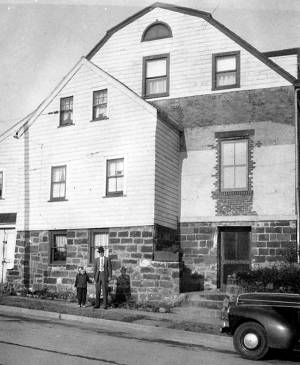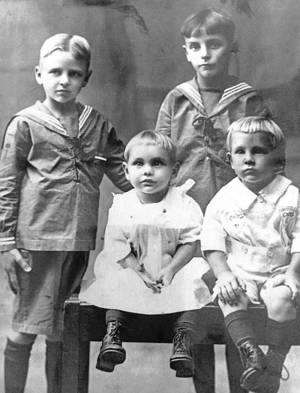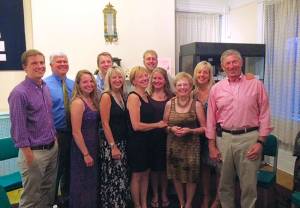The visit by 11 Noller descendants on Aug. 22 also served as a unique endorsement of the importance of preserving American heritage and the history of farming in the Meadowlands, which dates to the 17th century Dutch settlements of the Van Riper and Van Winkle families.
Joan (nee Noller) Jakelis with her father, John Noller Jr., visited the Rutherford homestead in 1946. Her grandfather was the last Noller to actively farm in Rutherford until 1929.
The Noller family event was a seventy-fifth birthday celebration for Joan Noller Jakelis, nicely organized by her daughters and attended by three generations of Noller descendants. These kinds of family events in the house, now headquarters for the Meadowlands Museum, are a Noller tradition that can be traced to the early 1890s when the farmstead was acquired by Joan Jakelis' great grandfather, John Charles Noller. Typically, farming families like the Nollers held wedding ceremonies, birthday celebrations, and funeral services in the house's parlor.
"It is a birthday I will never forget," said Joan Jakelis, surrounded by her loving children and grandchildren, some of whom traveled from as far away as California and Oregon. Mrs. Jakelis, who had last visited the Crane Avenue house as a child in 1946, was impressed to see her family's home being preserved as a museum. She and family members toured the entire house, including the attic, where Mrs. Jakelis recalled stories of her grandfather looking out over the meadows through an unusual oval window in his upstairs bedroom. She was pleased to see that the attic window is safely intact, under a newly installed roof.
Joan (nee Noller) Jakelis with her father, John Noller Jr., visited the Rutherford homestead in 1946. Her grandfather was the last Noller to actively farm in Rutherford until 1929.
Mrs. Jakelis, the Noller family genealogist, has traced her lineage to Ottendorf, Germany, where her great-grandfather John Charles Noller was born in 1858. He immigrated to America in 1882, landing in the immigrant depot called Castle Garden in lower Manhattan, where millions of immigrants were processed in the 19th century. Family records include Noller's name among the passengers of the Dutch ship WA Scholten, setting sail from Amsterdam September 15, 1882.
The 24-year-old German farmer married Rosa Catharina Gramm in New York on Aug. 5, 1885, according to the marriage certificate. It is believed the couple met at Castle Garden, where the German society often organized dances and socials. Rosa Gramm's father, David Gramm, and his sons had a small farm on Meadow Road in Rutherford, just north of the farmstead once owned by William Berry. Rosa and John Charles, sometimes referred to as Carl, had seven children, four of whom were born in the Noller house in Rutherford, which they purchased in 1891.
Mrs. Jakelis' great grandfather's biography was recorded in the 1922 "History of Bergen County," by Frances A. Westervelt, who once headed the Bergen County Historical Society. "The agricultural section of which Rutherford, N.J., is the center, is composed of prosperous, substantial farmers, among whom John Charles Noller is one of the most respected," states Westervelt's biographical sketch. Westervelt recounts that, while he "engaged in farming" in Germany, Noller worked for a few years as a waiter in a large New York restaurant before coming to Bergen County. He rented a farm in Rutherford that he operated for a year. He resided a short period in the Kingsland section of Lyndhurst.
The Noller and Gramm families were active in the German Evangelistic Church in Carlstadt, established as a Presbyterian church in 1869. According to the records of the church, now known as First Presbyterian Church of Carlstadt, John Charles Noller was a witness or the best man (the records are in German) in the marriage of his future wife's brother, Friedrich Gramm. The record of the marriage on March 26, 1885, identified Noller as a resident of Rutherford.
The Noller family's activity in the Carlstadt church spans the period of 1885 to 1925, about four years before they moved from Bergen County to reside and farm in the Millstone area of Monmouth County. The marriage ceremonies of two of John Charles Noller's daughters were performed at the Rutherford farmhouse by Rev. Ferdinand N. Kohler. "A quiet home wedding took place at the residence of Mr. and Mrs. J. C. Noller on Meadow Road," the August 24, 1918, account in the Rutherford Republican states. In 1925, Pastor Kohler performed the baptism of Walter James Babcock, Noller's grandson. When Rosa Catherine Noller died at age 60 in February 1920, an evening funeral service was conducted in the farmhouse, a fairly common practice in those days.
While most of the Noller children moved on, their son, John David, who was born November 7, 1892, about a year after the farm was acquired, stayed on to assist his father with the farming. Noller was a market farmer, meaning that garden vegetables like cabbage and potatoes, would be cultivated and later transported by truck to the nearest markets. Meadow Road, which was formerly Neck Road and Newark-Hackensack Turnpike, was typically used to truck crops to markets in Hackensack or Newark. The size of the Noller farm was once more than 50 acres, but reduced to less than 20 acres in the 1920s.
As the acreage of the farm reduced over time, so too did the farmhouse itself. A study done in 1938 by Historic American Buildings Survey (HABS) found that the main part of the house was built in 1804. The HABS surveyors claimed the original builder was John William Berry, a direct descendant of Major John Berry, a prominent 17th century landholder. "The present structure (meaning the Noller house and now Meadowlands Museum) was attached to the north end of the old Berry homestead which was torn down in 1929 to make way for a new street," according to the HABS report.
The early part of the 20th century saw changes underway around them that ultimately would contribute to the Noller family's decision to sell and move to a better economic climate in Monmouth County. Land owned by the estate of William N. Crane, west of Noller along Orient Way, became Appleton Heights, which created three new streets – William, Nevins and Crane. In 1928, the Borough of Rutherford sought to better serve real estate improvements with the construction of a sanitary sewer line through |

PHOTO COURTESY/JOAN JAKELIS
Joan (nee Noller) Jakelis with her father, John Noller Jr.,
visited the Rutherford homestead in 1946. Her
grandfather was the last Noller to actively farm in
Rutherford until 1929.

PHOTO COURTESY/MEADOWLANDS MUSEUM
The Noller children; back row, left to right, John Jr. and
Edward; front, left to right, Frances and Frederick. After
leaving Rutherford, John and Edward farmed in
Millstone, N.J., until 1968. The Noller family had farmed
a more-than-50 acre section, west of Berry's Creek, and
for four decades.
 PHOTO COURTESY/ROD LEITH PHOTO COURTESY/ROD LEITH
Three generations of the Noller descendants were on
hand to celebrate Joan's birthday on Aug. 22. Left to
right, James Patrick Hall (Joan's grandson), Thomas J.
Hall (son-in-law), Anne Elizabeth Hall (granddaughter),
Joseph Thomas Hall (grandson), Jill E. Jakelis (Joan's
daughter), Gail Jakelis Hall (daughter), Isaac Maiden
(granddaughter Katherine's fiance), Katherine Ann Hall
(granddaughter), Joan Noller Jakelis, Lynn Jakelis
Kearney (Joan's daughter) and Albert A. Jakelis (Joan's
husband).
|